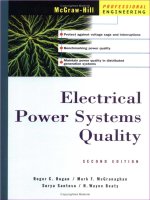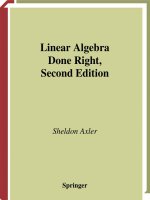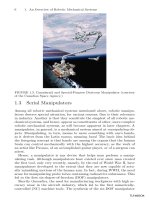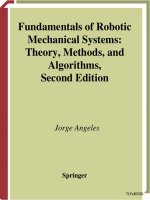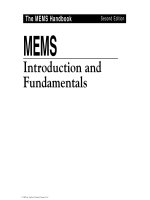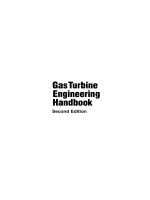- Trang chủ >>
- Khoa Học Tự Nhiên >>
- Vật lý
Accelerator physics, second edition
Bạn đang xem bản rút gọn của tài liệu. Xem và tải ngay bản đầy đủ của tài liệu tại đây (25.15 MB, 595 trang )
www.pdfgrip.com
Accelerator
Physics
Second Edition
www.pdfgrip.com
I
www.pdfgrip.com
Accelerator
Physic
Second E d i t i o n
S. Y. Lee
Department of Physics, Indiana University
\jjjp World Scientific
NEW JERSEY • LONDON • SINGAPORE • BEIJING • SHANGHAI • HONGKONG • TAIPEI • BANGALOf
www.pdfgrip.com
Published by
World Scientific Publishing Co. Pte. Ltd.
5 Toh Tuck Link, Singapore 596224
USA office: 27 Warren Street, Suite 401-402, Hackensack, NJ 07601
UK office: 57 Shelton Street, Covent Garden, London WC2H 9HE
British Library Cataioguing-in-Publication Data
A catalogue record for this book is available from the British Library.
ACCELERATOR PHYSICS (Second Edition)
Copyright © 2004 by World Scientific Publishing Co. Pte. Ltd.
All rights reserved. This book, or parts thereof, may not be reproduced in any form or by any means,
electronic or mechanical, including photocopying, recording or any information storage and retrieval
system now known or to be invented, without written permission from the Publisher.
For photocopying of material in this volume, please pay a copying fee through the Copyright Clearance
Center, Inc., 222 Rosewood Drive, Danvers, MA 01923, USA. In this case permission to photocopy
is not required from the publisher.
ISBN 981-256-182-X
981-256-200-1 (pbk)
www.pdfgrip.com
To the memory of my parents
www.pdfgrip.com
www.pdfgrip.com
Preface
Since the appearance of the first edition in 1999, this book has been used as a textbook or reference for graduate-level "Accelerator Physics" courses. I have benefited
from questions, criticism and suggestions from colleagues and students. As a response to these suggestions, the revised edition is intended to provide easier learning
explanations and illustrations.
Accelerator Physics studies the interaction between the charged particles and electromagnetic field. The applications of accelerators include all branches of sciences and
technologies, medical treatment, and industrial processing. Accelerator scientists invent many innovative technologies to produce beams with qualities required for each
application.
This textbook is intended for graduate students who have completed their graduate core-courses including classical mechanics, electrodynamics, quantum mechanics,
and statistical mechanics. I have tried to emphasize the fundamental physics behind
each innovative idea with least amount of mathematical complication. The textbook
may also be used by undergraduate seniors who have completed courses on classical
mechanics and electromagnetism. For beginners in accelerator physics, one begins
with Sees. 2.1-2.4 in Chapter 2, and follows by Sees. 3.1-3.2 for the basic betatron and synchrotron motion. The study continues onto Sees. 2.5, 2.8, and 3.7 for
chromatic aberration and collective beam instabilities. After these basic topics, the
rf technology and basic physics of linac are covered in Sees. 3.5, 3.6, 3.8 in Chapter
3. The basic accelerator physics course ends with physics of electron storage rings in
Chapter 4.
I have chosen the Frenet-Serret coordinate-system of (x, s, z) for the transverse
radially-outward, longitudinally-forward, and vertical unit base-vectors with the righthand rule: z = x x I. I have also chosen positive-charge to derive the equations of
betatron motion for all sections of the Chapter 2, except a discussion of ±-signs in
Eq. (2.29). The sign of some terms in Hill's equation should be reversed if you solve
the equation of motion for electrons in accelerators.
The convention of the rf-phase differs in linac and synchrotron communities by
4>\mac = ^synchrotron — (TT/2) • To be consistent with the synchrotron motion in Chapter
3, I have chosen the rf-phase convention of the synchrotron community to describe
the synchrotron equation of motion for linac in Sec. 3.8.
In this revised edition, I include two special topics: free electron laser (FEL)
vii
www.pdfgrip.com
viii
PREFACE
and beam-beam interaction in Chapter 5. In 2000, several self-amplified spontaneous
emission (SASE) FEL experiments have been successfully demonstrated. Many light
source laboratories are proposing the fourth generation light source using high gain
FEL based on the concept of SASE and high-gain harmonic generation (HGHG).
Similarly, the success of high luminosity B-factories indicates that beam-beam interaction remains very important to the basic accelerator physics. These activities
justify the addition of two introductory topics to the accelerator physics text.
Finally, the homework is designed to solve a particular problem by providing
step-by-step procedures to minimize frustrations. The answer is usually listed at the
end of each homework problem so that the result can be used in practical design of
accelerator systems. I would appreciate very much to receive comments and criticism
to this revised edition.
S.Y. Lee
Bloomington, Indiana, U.S.A.
November, 2004
www.pdfgrip.com
Preface to the first edition
The development of high energy accelerators began in 1911 when Rutherford discovered the atomic nuclei inside the atom. Since then, high voltage DC and rf accelerators have been developed, high-field magnets with excellent field quality have been
achieved, transverse and longitudinal beam focusing principles have been discovered,
high power rf sources have been invented, high vacuum technology has been improved,
high brightness (polarized/unpolarized) electron/ion sources have been attained, and
beam dynamics and beam manipulation schemes such as beam injection, accumulation, slow and fast extraction, beam damping and beam cooling, instability feedback,
etc. have been advanced. The impacts of the accelerator development are evidenced
by many ground-breaking discoveries in particle and nuclear physics, atomic and
molecular physics, condensed-matter physics, biomedical physics, medicine, biology,
and industrial processing.
Accelerator physics and technology is an evolving branch of science. As the technology progresses, research in the physics of beams propels advancement in accelerator
performance. The advancement in type II superconducting material led to the development of high-field magnets. The invention of the collider concept initiated research
and development in single and multi-particle beam dynamics. Accelerator development has been impressive. High energy was measured in MeV's in the 1930's, GeV's
in the 1950's, and multi-TeV's in the 1990's. In the coming decades, the center of
mass energy will reach 10-100 TeV. High intensity was 109 particles per pulse in the
1950's. Now, the AGS has achieved 6 x 1013 protons per pulse. We are looking for
1014 protons per bunch for many applications. The brilliance of synchrotron radiation
was about 1012 [photons/s mm2 mrad2 0.1% (AA/A)] from the first-generation light
sources in the 1970's. Now, it reaches 1021, and efforts are being made to reach a
brilliance of 1029 - 1034 in many FEL research projects.
This textbook deals with basic accelerator physics. It is based on my lecture notes
for the accelerator physics graduate course at Indiana University and two courses
in the U.S. Particle Accelerator School. It has been used as preparatory course
material for graduate accelerator physics students doing thesis research at Indiana
University. The book has four chapters. The first describes historical accelerator
development. The second deals with transverse betatron motion. The third chapter
concerns synchrotron motion and provides an introduction to linear accelerators. The
fourth deals with synchrotron radiation phenomena and the basic design principles
ix
www.pdfgrip.com
x
PREFACE TO THE FIRST EDITION
of low-emittance electron storage rings. Since this is a textbook on basic accelerator
physics, topics such as nonlinear beam dynamics, collective beam instabilities, etc.,
are mentioned only briefly, in Chapters 2 and 3.
Attention is paid to deriving the action-angle variables of the phase space coordinates because the transformation is basic and the concept is important in understanding the phenomena of collective instability and nonlinear beam dynamics. In
the design of synchrotrons, the dispersion function plays an important role in particle stability, beam performance, and beam transport. An extensive section on the
dispersion function is provided in Chapter 2. This function is also important in the
design of low-emittance electron storage ring lattices.
The SI units are used throughout this book. I have also chosen the engineer's
convention of j = —i for the imaginary number. The exercises in each section are
designed to have the student apply a specific technique in solving an accelerator
physics problem. By following the steps provided in the homework, each exercise can
be easily solved.
The field of accelerator physics and technology is multi-disciplinary. Many related
subjects are not extensively discussed in this book: linear accelerators, induction
linacs, high brightness beams, collective instabilities, nonlinear dynamics, beam cooling physics and technology, linear collider physics, free-electron lasers, electron and
ion sources, neutron spallation sources, muon colliders, high intensity beams, vacuum
technology, superconductivity, magnet technology, instrumentation, etc. Nevertheless, the book should provide the understanding of basic accelerator physics that is
indispensable in accelerator physics and technology research.
S.Y. Lee
Bloomington, Indiana, U.S.A.
January, 1998
www.pdfgrip.com
Contents
Preface
vii
Preface to the first edition
ix
1 Introduction
I
Historical Developments
I.1
Natural Accelerators
I.2
Electrostatic Accelerators
I.3
Induction Accelerators
I.4
Radio-Frequency (RF) Accelerators
I.5
Colliders and Storage Rings
I.6
Synchrotron Radiation Storage Rings
II
Layout and Components of Accelerators
II.1
Acceleration Cavities
II.2
Accelerator Magnets
II.3
Other Important Components
III Accelerator Applications
III.1 High Energy and Nuclear Physics
III.2 Solid-State and Condensed-Matter Physics
III.3 Other Applications
Exercise
1
4
5
6
6
9
17
18
19
19
20
22
23
23
24
24
24
2 Transverse Motion
I
Hamiltonian for Particle Motion in Accelerators
I.1
Hamiltonian in Frenet-Serret Coordinate System
I.2
Magnetic Field in Frenet-Serret Coordinate System
I.3
Equation of Betatron Motion
I.4
Particle Motion in Dipole and Quadrupole Magnets
Exercise
II Linear Betatron Motion
II. 1 Transfer Matrix and Stability of Betatron Motion
II.2
Courant-Snyder Parametrization
II.3
Floquet Transformation
35
36
37
39
41
41
42
47
47
51
52
xi
www.pdfgrip.com
xii
CONTENTS
III
IV
V
VI
II.4
Action-Angle Variable and Floquet Transformation
II.5
Courant-Snyder Invariant and Emittance
II.6
Stability of Betatron Motion: A FODO Cell Example
II.7
Symplectic Condition
II.8
Effect of Space-Charge Force on Betatron Motion
Exercise
Effect of Linear Magnet Imperfections
III.1 Closed-Orbit Distortion due to Dipole Field Errors
III.2 Extended Matrix Method for the Closed Orbit
III.3 Application of Dipole Field Error
III.4 Quadrupole Field (Gradient) Errors
III.5 Basic Beam Observation of Transverse Motion
III.6 Application of quadrupole field error
III.7 Transverse Spectra
III.8 Beam Injection and Extraction
III.9 Mechanisms of emittance dilution and diffusion
Exercise
Off-Momentum Orbit
IV.1 Dispersion Function
IV.2 %-Function, Action, and Integral Representation
IV.3 Momentum Compaction Factor
IV.4 Dispersion Suppression and Dispersion Matching
IV.5 Achromat Transport Systems
IV.6 Transport Notation
IV.7 Experimental Measurements of Dispersion Function
IV.8 Transition Energy Manipulation
A. 7T jump schemes
B. Flexible momentum compaction (FMC) lattices
C. Other similar FMC modules
D. FMC in double-bend (DB) lattices
IV.9 Minimum {H) Modules
Exercise
Chromatic Aberration
V.I
Chromaticity Measurement and Correction
V.2
Nonlinear Effects of Chromatic Sextupoles
V.3
Chromatic Aberration and Correction
V.4
Lattice Design Strategy
Exercise
Linear Coupling
VI.1 The Linear Coupling Hamiltonian
VI.2 Effects of an isolated Linear Coupling Resonance
VI.3 Experimental Measurement of Linear Coupling
www.pdfgrip.com
57
60
65
66
67
73
85
85
91
92
101
105
108
110
115
117
121
129
129
133
136
139
141
143
145
146
146
149
155
156
157
161
172
173
178
178
183
184
186
186
189
193
xiii
CONTENTS
VI.4 Linear Coupling Correction with Skew Quadrupoles
VI.5 Linear Coupling Using Transfer Matrix Formalism
Exercise
VII Nonlinear Resonances
VII. 1 Nonlinear Resonances Driven by Sextupoles
VII.2 Higher-Order Resonances
VII.3 Nonlinear Detuning from Sextupoles
VII.4 Betatron Tunes and Nonlinear Resonances
Exercise
VIII Collective Instabilities and Landau Damping
VIII.1 Impedance
VIII.2 Transverse Wave Modes
VIII.3 Effect of Wakefield on Transverse Wave
VIII.4 Frequency Spread and Landau Damping
Exercise
IX Synchro-Betatron Hamiltonian
Exercise
3 Synchrotron Motion
I
Longitudinal Equation of Motion
I.1
The Synchrotron Hamiltonian
I.2
The Synchrotron Mapping Equation
I.3
Evolution of Synchrotron Phase-Space Ellipse
I.4
Some Practical Examples
I.5
Summary of Synchrotron Equations of Motion
Exercise
II Adiabatic Synchrotron Motion
II.1
Fixed Points
II.2
Bucket Area
II.3
Small-Amplitude Oscillations and Bunch Area
II.4
Small-Amplitude Synchrotron Motion at the UFP
II.5
Synchrotron Motion for Large-Amplitude Particles
II.6
Experimental Tracking of Synchrotron Motion
Exercise
III RF Phase and Voltage Modulations
III.1 Normalized Phase-Space Coordinates
III.2 RF Phase Modulation and Parametric Resonances
III.3 Measurements of Synchrotron Phase Modulation
III.4 Effects of Dipole Field Modulation
III.5 RF Voltage Modulation
III.6 Measurement of RF Voltage Modulation
Exercise
www.pdfgrip.com
196
197
197
202
202
209
211
212
213
216
216
220
221
225
228
232
237
239
240
244
245
246
247
248
249
251
252
253
255
258
259
261
263
268
268
271
277
280
288
295
297
xiv
CONTENTS
IV
Nonadiabatic and Nonlinear Synchrotron Motion
IV. 1 Linear Synchrotron Motion Near Transition Energy
IV.2 Nonlinear Synchrotron Motion at 7 « 7T
IV. 3 Beam Manipulation Near Transition Energy
IV.4 Synchrotron Motion with Nonlinear Phase Slip Factor
IV.5 The QI Dynamical Systems
Exercise
V Beam Manipulation in Synchrotron Phase Space
V.I
RF Frequency Requirements
V.2
Capture and Acceleration of Proton and Ion Beams
V.3
Bunch Compression and Rotation
V.4
Debunching
V.5
Beam Stacking and Phase Displacement Acceleration
V.6
Double rf Systems
V.7
The Barrier RF Bucket
Exercise
VI Fundamentals of RF Systems
VI.1 Pillbox Cavity
VI.2 Low Frequency Coaxial Cavities
VI.3 Beam Loading
VI.4 Beam Loading Compensation and Robinson Instability . . . .
Exercise
VII Longitudinal Collective Instabilities
VII.1 Longitudinal Spectra
VII.2 Collective Microwave Instability in Coasting Beams
VII.3 Longitudinal Impedance
VII.4 Microwave Single Bunch Instability
Exercise
VIII Introduction to Linear Accelerators
VIII.1 Historical Milestones
VIII.2 Fundamental Properties of Accelerating Structures
A. Transit time factor
B. Shunt impedance
C. The quality factor Q
VIII.3 Particle Acceleration by EM Waves
A. EM waves in a cylindrical wave guide
B. Phase velocity and group velocity
C. TM modes in a cylindrical pillbox cavity
D. Alvarez structure
E. Loaded wave guide chain and the space harmonics
F. Standing wave, traveling wave, and coupled cavity linacs ..
G. HOMs
www.pdfgrip.com
301
302
305
308
309
312
315
317
318
320
322
326
326
327
334
340
343
343
345
353
356
359
362
363
367
369
373
381
383
383
387
387
388
388
389
390
391
392
395
396
399
401
xv
CONTENTS
VIII.4 Longitudinal Particle Dynamics in a Linac
VIII.5 Transverse Beam Dynamics in a Linac
Exercise
402
407
410
4 Physics of Electron Storage Rings
I
Fields of a Moving Charged Particle
I.1
Non-relativistic Reduction
I.2
Radiation Field for Particles at Relativistic Velocities
I.3
Frequency and Angular Distribution
I.4
Quantum Fluctuation
Exercise
II
Radiation Damping and Excitation
II. 1 Damping of Synchrotron Motion
II.2
Damping of Betatron Motion
II.3
Damping Rate Adjustment
II.4
Radiation Excitation and Equilibrium Energy Spread
II.5
Radial Bunch Width and Distribution Function
II.6
Vertical Beam Width
II.7
Radiation Integrals
II.8
Beam Lifetime
Exercise
III Emittance in Electron Storage Rings
III.1 Emittance of Synchrotron Radiation Lattices
A. FODO cell lattice
B. Double-bend achromat (Chasman-Green lattice)
C. Minimum (H)-function lattice
D. Minimizing emittance in a combined function DBA
E. Three-bend achromat
III.2 Insertion Devices
III.3 Beam Physics of High Brightness Storage Rings
Exercise
417
422
424
424
427
433
435
437
438
441
445
448
453
455
456
456
462
466
467
467
469
473
475
476
478
486
489
5 Special Topics in Beam Physics
I
Free Electron Laser (FEL)
I.1
Small Signal Regime
I.2
Interaction of the Radiation Field with the Beam
I.3
Experiments on High Gain FEL Generation
Exercise
II
Beam-Beam Interaction
II.1
The beam-beam force
II.2
The Coherent Beam-Beam Effects
II.3
Nonlinear Beam-Beam Effects
497
498
500
506
509
510
513
517
519
521
www.pdfgrip.com
xvi
CONTENTS
II.4
Experimental Observations and Numerical Simulations . . . . 522
II.5
B e a m - B e a m Interaction in Linear Colliders
525
Exercise
527
A Basics of Classical Mechanics
I
Hamiltonian Dynamics
I.1
Canonical Transformations
I.2
Fixed Points
I.3
Poisson Bracket
I.4
Liouville Theorem
I.5
Floquet Theorem
II
Stochastic Beam Dynamics
II.l
Central Limit Theorem
II. 2
Langevin Equation of Motion
II.3
Stochastic Integration Methods
II.4
Fokker-Planck Equation
533
533
533
534
534
535
536
537
537
538
539
541
B Numerical Methods and Physical Constants
Fourier Transform
I
I.1
Nyquist Sampling Theorem
I.2
Discrete Fourier Transform
I.3
Digital Filtering
I.4
Some Simple Fourier Transforms
II
Model Independent Analysis
III
Model Independent Analysis
II. 2 Independent Component Analysis
II.3
Accelerator Modeling
III Cauchy Theorem and the Dispersion Relation
III.1 Cauchy Integral Formula
III.2 Dispersion Relation
IV Useful Handy Formulas
IV. 1 Generating functions for the Bessel functions
IV.2 The Hankel transform
IV.3 The complex error function
IV.4 A multipole expansion formula
IV.5 Cylindrical Coordinates
IV.6 Gauss' and Stokes' theorems
IV.7 Vector Operation
V Maxwell's equations
V.I
Lorentz Transformation of EM
fields
V.2
Cylindrical waveguides
V.3
Voltage Standing Wave Ratio
543
543
544
544
545
546
546
547
548
549
549
549
550
551
551
551
551
552
552
553
553
553
554
554
556
www.pdfgrip.com
xvii
CONTENTS
VI
Physical Properties and Constants
557
Bibliography
561
Index
563
Symbols and Notations
571
www.pdfgrip.com
Acknowledgments
I would like to thank students and colleagues, particularly D. Li, H. Huang, X. Kang,
M. Ellison, K.M. Fung, M. Bai, A. Riabko, who helped me polish the lecture notes into
a book form. I would like to thank S. Cousineau, C. Beltran, S. Breitzmann, W. Guo,
X. Huang, V. Ranjbar, and Y. Zhang, who made many useful suggestions to this
revised edition. I would like to thank Angela Bellavance for pointing out mis-prints
during a USPAS program in 2001. During the course of this work, I have benefited
greatly from the collaboration with Drs. David Caussyn, Y. Wang, D. Jeon, K.Y. Ng,
Y. Yan and Prof. A. Chao. I owe special thanks to Margaret Dienes for editing the
first edition of this book. I owe special thanks to Prof. Jau-Jiun Hsiao for making
critical suggestions to the new chapter in this revised edition. The responsibility for
all errors lies with me. Your comments and corrections will be highly appreciated.
xviii
www.pdfgrip.com
Chapter 1
Introduction
The first accelerator dates back to prehistoric-historic times, when men built bows
and arrows for hunting. The race to build modern particle accelerators began in 1911
when Rutherford discovered the nucleus by scattering a-particles off Aluminum foil.
The physics and technology of accelerators and storage rings involves many branches
of science. These include electromagnetism, solid-state properties of materials, atomic
physics, superconductivity,1 nonlinear mechanics, spin dynamics, plasma physics, and
quantum physics. In recent years, accelerators have found many applications: they
are used in nuclear and particle physics research, in industrial applications such as
ion implantation and lithography, in biological and medical research with synchrotron
light sources, in material science and medical research with spallation neutron sources,
etc. Accelerators have also been used for radiotherapy, food sterilization, waste treatment, etc.
A major application of particle accelerators is experimental nuclear and particle
physics research. Advances in technology have allowed remarkable increases in energy
and luminosity2 for fundamental physics research. High energy was measured in
MeV's in the 1930's, and is measured in TeV's in the 1990's. The beam intensity
was about 109 particles per pulse (ppp) in the 1950's, and is about 1014 ppp in the
1990's. Since 1970, high energy and high luminosity colliders have become basic tools
in nuclear and particle physics research. As physicists probe deeper into the inner
structure of matter, high energy provides new territory for potential discoveries, and
indeed new energy frontiers usually lead to new physics discoveries. The evolution of
1 Superconductivity was discovered by Heike Kamerlingh Onnes in 1911. The Meissner effect
was discovered in 1933. Understanding of the microscopic basis of superconductivity was achieved
by John Bardeen, Leon Cooper, and Robert Schrieffer in 1957. High temperature superconductor
was discovered by K.A. Mueller and J.G. Bednorz in 1986. Fine meshed superconducting wires are
usually used in high-field magnets. Superconducting thin films deposited on the cavity surface are
used for superconducting cavities.
2 The luminosity C is denned as the probability of particle encountering rate per unit area in a
collision process (see Exercise 1.7). The commonly used dimension is cm"2 s" 1 . The counting rate
in a detector is given by £u, where a is the cross-section of a reaction process.
1
www.pdfgrip.com
2
CHAPTER! INTRODUCTION
accelerator development can be summarized by the Livingston chart shown in Fig. 1.1,
where the equivalent fixed target proton energy, KE = s/(2m p c 2 ) (see Exercise 1.6),
is plotted as a function of time.
> l o 2 1 I " I " " I ^' " I " "
1
'
I
I lo18 "
U
! *
=
£
|
o
y
- °
S
s
|
109
<
1Q6
l ^ ' I l I TOW
l i
|
|
I 1
1 -
_
lol2
B
I
,-*"V«
g
I
\ IQ15 _
g*
S
2
«
I
|
I" " I" " I' '
«»->*«~'
""^r
*K S
W
M
.
/ri™»)HT'
| ^jf jrfp
-^--^rfi
„»"'"
pjg u r e U ; xhe Livingston
Chart: The equivalent fixed
target proton beam energy
versus time in years. Note
—
* n a ' ; innovative ideas provide
substantial jump in beam en-
o» 'CPQ_—&-^P Electron lin a c
J P j ^ T ^
Hô*ron Synchrotron (strong focusing)
PTP"V
-
_1
S .^ygtfđ g Proton lln.c
. | .^fLe^=_Ji
c'1""- " ctor ' cu " d
- fi^&$rf~~~'**' n"*""u""! ããằã"ô"
^
.
.
el &y-
TTlP
-1-Ile
HflsTlpH
U d 4 I l e U
llTIP
1 1 I l e
m
l b
drawn to guide the trend,
which is beam energy doubling in every two years.
Rectifier generator
°
J c v i T
_
.
i . . . . i . . . . i . . . . i . . . . i ..
1940
1960
1980
2000
year
2020
2040
In recent years, high-brilliance photon beams from high-brightness electron beams
in storage rings3 have been extensively used in biomedical and condensed-matter
physics research. Figure 1.2 shows the peak photon brilliance (number of photons/(mm2
mrad2 s (0.1% Aw/w)) as a function of photon beam energy from storage rings and
linacs.
•
'
—
^ l .
'I'0** \
— lO 1311
'
TESU LCLS
'
8 .
^ ^ ,.-.=.
n 2
ã
^
ã
- io24
-
ằSLSXl^p^
,i
I
\
"
"
.Jt-=Tvr""
ã^ ~
12 ^ ^
\
{"ôôô,
o
/\
/
^
10~ 2
-
_ 10 28
/ ^ ^ ^
\
t i g u r e 1.2:
The peak
- " ' ~~~~.
/ »siin ^ ^ „ - - _\
5 and
average
Photon
» * " " " * * " - loie _
s"ctLo1u,,„,„!<,„- 5
Brilliance
denned
as
I-
/
10 2 0
'•
Undulator (8-8 GeV)
v
s
'
—
10
.
I
10" 1 10°
101
photon energy (keV)
108
I ,1
102
c K
I"
I
photons/(mm 2 mrad 2 s
• ? e n e l ;S y S e a t e d by high
- S quality electron beams in
•
storage rings and m hnacs.
Cu _tJ" K
_
Đ
ã |
(0.1%Aw/w))
is
plotted
_ $ã as a function photon beam
c.-, ã ô
:
x
^
-^
Br.m,,tr^l^,-
Z j A
1 0 " 2 10" 1 10°
101
photon energy (keV)
I,
102
Besides being used for fundamental material science research, high-intensity neu3 The
brightness of a beam is denned as the beam's intensity divided by its phase-space volume.
www.pdfgrip.com
3
ACCELERATOR PHYSICS
tron sources driven by powerful proton beam sources may provide energy amplification for future global energy needs. High intensity heavy-ion beams have also been
actively pursued for inertial fusion evaluation.
Frontiers in accelerator physics and technology research
Accelerator physics is a branch of applied science. Innovations in technology give
rise to new frontiers in beam physics research. Since higher energy leads to new
discoveries, and higher luminosity leads to higher precision in experimental results,
the frontiers of accelerator physics research are classified into the frontiers of high
energy and high brightness. Some of these topics in beam physics are as follows.
• High energy: For high energy hadron accelerators such as the Tevatron at Fermilab, the Large Hadron Collider (LHC) at CERN, and the contemplated Very
Large Hadron Collider (VLHC), high-field superconducting magnets and the
stability of high-brightness beams are important issues. For lepton colliders,
high acceleration gradient structures, wakefields, and high power rf sources are
important. Some proposed e+e~ colliders are the Next Linear Collider (NLC),
the Japan Linear Collider (JLC), the CERN Linear Collider (CLIC), and the
TeV Superconducting Linear Accelerator (TESLA), which employs superconducting rf cavities. Current research topics include high rf power sources, high
acceleration gradients, wakefield control, etc.
• High luminosity: To provide a detailed understanding of CP violation and other
fundamental symmetry principles of interactions, dedicated meson factories such
as the $-factory at Frascati National Laboratory in Italy and the B-factories at
SLAC and Cornell in the U.S. and at KEK in Japan were built in the 1990's,
and the Tau-Charm factory is being contemplated in Beijing, China. Since
the neutron flux from spallation neutron sources is proportional to the proton
beam power, physics and technology for high-intensity low-loss proton sources
are important.4 Furthermore, a high-intensity proton source can be used to
drive secondary beams such as kaons, pions, and muons. With high-intensity yu
beams, /J,+/J,~ collider studies are also of current interest.
• High-brightness beams: Beam-cooling techniques have been extensively used in
attaining high-brightness hadron beams. Stochastic cooling has been successfully applied to accumulate anti-protons. This led to the discovery of W and
Z bosons, and b and t quarks. Electron cooling and laser cooling have been
applied to many low energy storage rings used in atomic and nuclear physics research. Ionization cooling is needed for muon beams in fi+fJ,~ colliders. Taking
advantage of radiation cooling, synchrotron light sources with high-brightness
electron beams are used in medical, biological, and condensed-matter physics
4 See
e.g., the National Spallation Neutron Source Design Report (Oak Ridge, 1997).
www.pdfgrip.com
4
CHAPTER 1.
INTRODUCTION
research. Sub-picosecond photon beams would be important to time-resolved
experiments. A high power tunable free-electron laser would be useful for chemical and technical applications.
• Accelerator applications: The medical use of accelerators for radiation treatment,5 isotope production, sterilization of medical tools, etc., requires safety,
reliability, and ease in operation. Higher beam power density with minimum
beam loss can optimize safety in industrial applications such as ion implantation, electron-beam welding, material testing, food sterilization, etc.
Recent research topics in accelerator physics include beam cooling, nonlinear beam
dynamics, beam-beam interactions, collective beam instability, beam manipulation
techniques, ion sources, space-charge effects, beam instrumentation development,
novel acceleration techniques, etc. Accelerator technology research areas include superconducting materials, high power rf sources, high gradient accelerating structures,
etc. This book deals only with the fundamental aspects of accelerator physics. It
serves as an introduction to more advanced topics such as collective beam instabilities, nonlinear beam dynamics, beam-cooling physics and technologies, rf physics and
technology, magnet technology, etc. First, the technical achievements in accelerator
physics of past decades will be described.
I
Historical Developments
A charged particle with charge q and velocity v in the electromagnetic fields (E, B)
is exerted by the Lorentz's force F:
F = q(E + vxB).
(1.1)
The charge particle can only gain or lose its energy by its interaction with the electric
field E. Since the magnetic force is perpendicular to both v and B, the charged
particle will move on a circular arc. In particular, when the magnetic flux density is
perpendicular to v, the bending radius is
where m and p = mv are the mass and momentum of the particle. The momentum
rigidity of the charged particle is
Bp [T-m] = ? = ^ x 3.33564 x p [GeV/c/u],
q Z
5 See
e.g., P.L. Petti and A.J. Lennox, ARNS 44, 155 (1994).
www.pdfgrip.com
(1.3)
I. HISTORICAL DEVELOPMENTS
5
where Bp is measured in Tesla-meter, and the momentum is measured in GeV/c per
amu, and A and Ze are the atomic mass number and charge of the particle.
Accelerators are composed of ion sources, cavity and magnet components that can
generate and maintain electromagnetic fields for beam acceleration and manipulation,
devices to detect beam motion, high vacuum components for attaining excellent beam
lifetime, undulators and wigglers to produce high brilliance photon beam, targets for
producing secondary beams, etc. Accelerators can be classified as linear or circular,
electrostatic or radio frequency, continuous (CW, DC or coasting beam) or bunched
and pulsed. They are designed to accelerate electrons (leptons) or hadrons, stable
or radioactive ions. Accelerators are classified as follows, in no specific chronological
order.
I.I
Natural Accelerators
Radioactive accelerators
In 1911, Rutherford employed a particles escaping the Coulomb barrier of Ra and Th
nuclei to investigate the inner structure of atoms.6 He demonstrated, to the surprise
of many physicists, the existence of a positively charged nucleus with a diameter
less than 10"11 cm. This led to the introduction of Bohr's atomic model, and the
revolution of quantum mechanics in the early 20th century. In 1919, Rutherford
also used a particles to induce the first artificial nuclear reaction, a + 14N —> 17O
+ H. This discovery created an era of search for high-voltage sources for particle
acceleration that can produce high-intensity high-energy particles for the study of
nuclear transmutation.
Cosmic rays
Cosmic rays arise from galactic source accelerators. Nuclei range from n and H to
Ni; heavy elements have been measured with energies up to 3 x 1020 eV.7 Muons
were discovered in cosmic-ray emulsion experiments in 1936 by CD. Anderson, S.H.
Neddermeyer, and others. Pions were discovered in 1947 in emulsion experiments.
Interest in the relativistic heavy ion collider (RHIC) was amplified by the cosmic ray
emulsion experiments.
6The kinetic energy of a particles that tunnel through the Coulomb barrier to escape the nuclear
force is typically about 6 MeV.
7See J.A. Simpson, Ann. Rev. Nucl. Sci. 33, 323 (1983) and R. Barnett et al, Phys. Rev.
(Particle Data Group) D54, 1 (1996). An event with energy 3 x 1020 eV had been recorded in 1991
by the Fly's Eye atmospheric-fluorescence detector in Utah (see Physics Today, p. 19, Feb. 1997;
p. 31, Jan. 1998).
www.pdfgrip.com
6
1.2
CHAPTER 1. INTRODUCTION
Electrostatic Accelerators
X-ray tubes
William David Coolidge in 1926 achieved 900-keV electron beam energy by using
three X-ray tubes in series. The cascade type of X-ray tube is called the Coolidge
tubes.
Cockcroft-Walton electrostatic accelerator
In 1930, John Douglas Cockcroft and Ernst Thomas Sinton Walton developed a highvoltage source by using high-voltage rectifier units. In 1932, they reached 400-kV
terminal voltage to achieve the first man-made nuclear transmutation: p + Li —»
2 He.8 The maximum achievable voltage was limited to about 1 MV because of
sparking in air. Since then, Cockcroft-Walton accelerators have been widely used in
first-stage ion-beam acceleration. More recently, they are being replaced by more
compact, economical, and reliable radio frequency quadrupole (RFQ) accelerators.
Van de Graaff and tandam accelerators
In 1931, R.J. Van de Graaff developed the electrostatic charging accelerator.9 In the
Van de Graaff accelerator, the rectifier units are replaced by an electrostatic charging
belt, and the high-voltage terminal and the acceleration tube are placed in a common
tank with compressed gas for insulation, which increases the peak acceleration voltage.
Placement of the high-voltage terminal at the center of the tank and use of the chargeexchange process in the tandem accelerator can increase the beam energy for nuclei.10
Today the voltage attained in tandem accelerators is about 25 MV. When the Van de
Graaff accelerator is used for electron acceleration, it has the brand name Pelletron.
1.3
Induction Accelerators
According to Faraday's law of induction, when the magnetic flux changes, the induction electric field along a beam path is given by
ie-ds = $,
$= f B-dS.
(1.4)
J
Js
Here £ is the induced electric field, $ is the total magnetic flux, ds*is the differential
for the line integral that surrounds the surface area, dS is the differential for the
8 J.D. Cockcroft and E.T.S. Walton, Proc. Roy. Soc. A136, 619 (1932); A137, 229 (1932); A144,
704 (1934). Cockcroft and Walton shared 1951 Nobel Prize in physics.
9 R.J. Van de Graaff, J.G. Trump, and W.W. Buechner, Rep. Prog. Phys. 11, 1 (1946).
1 0 R.J. Van de Graaff, Nucl. Inst. Methods 8, 195 (1960).
www.pdfgrip.com



